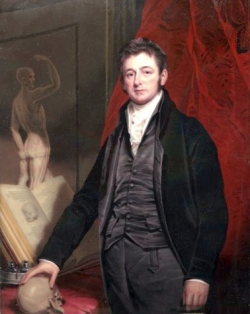Sir Anthony Carlisle

- Born
- 15 February 1768
- Died
- 2 December 1840 (age 72)
Naked guardsmen and gothic novels are not things that spring to mind when you are asked to think of a typical surgeon, but then Anthony Carlisle was far from typical. Born in 1768 in Stillington, a village in County Durham, Carlisle started his medical career training with his uncle in York. He then trained with a surgeon in the City of Durham before moving to London, where he became a surgeon at Westminster Hospital in 1793. He held this position until his death in 1840.
Carlisle had a full and varied career. He specialised in bones of the inner ear, structure of the spleen and thyroid gland, and studied the effects of inbreeding, electrochemistry, the spread of cholera and evolution. Within his surgical work, he introduced a thin-bladed, straight-edged amputating knife, in place of the old clumsy crooked one. One of his innovations was the collection, analysis and publication of medical statistics. As early as 1838, he used the phrase ‘selecting the fit’.
He accomplished a great deal. Along with William Nicholson, he co-discovered electrolysis in 1800, after passing a voltaic current through water, although he did not pursue this observation further. The apparatus he used was later modified by chemist Humphry Davy, who discovered several alkali and alkaline earth metals.
Carlisle was elected a Fellow of the Royal Society in 1804 and became professor of anatomy at the Royal Academy in 1808. He had studied art at the Academy when he first arrived in London. Carlisle was a founding member of the Royal College of Surgeons, and was twice its president. He had Royal Appointments, firstly to the Duke of Gloucester and then to King George IV. He was also a curator of the Hunterian museum for many years.
He was fascinated by the musculature of the human body and conveyed this in his lively lectures. In order to illustrate his anatomy talks, he arranged for a number of guest visitors to perform naked, including eight Life Guardsmen going through their sword exercises and a troupe of Chinese jugglers. It was reported he handed around human remains on plates. His lectures were so popular that police had to stand at the door to control the crowds that gathered.
Carlisle’s role at Westminster Hospital was unpaid, and to fund his comparative anatomy experiments, it is believed that he wrote gorily gothic novels under the pseudonym Mrs Carver. One of these books, The Horrors of Oakendale Abbey, was about body snatching. It is also possible that he may have been the inspiration for Mary Shelley’s Frankenstein.
Some of Carlisle's presentations would be unacceptable today and his legacy is less well known now but in his time he achieved significant influence on science and public knowledge. Surgery, anatomy, statistics, art and literature – Carlisle was a man of many talents.
Sir Anthony Carlisle, the best of story tellers and surgeons



